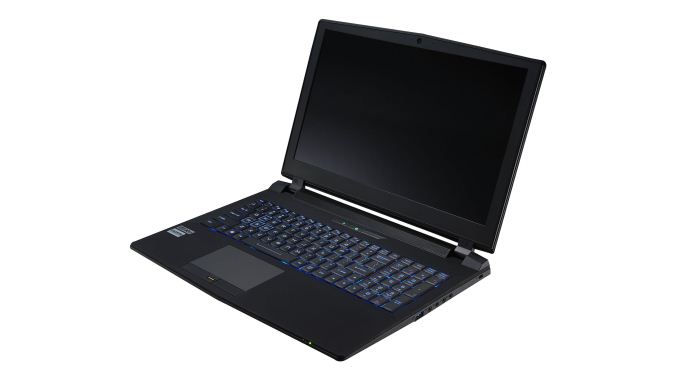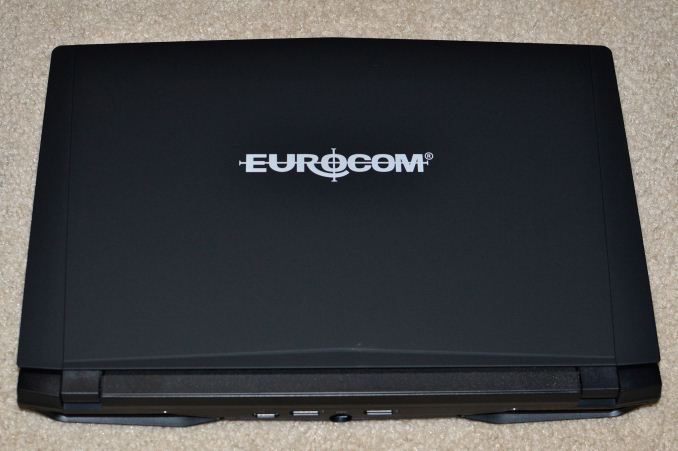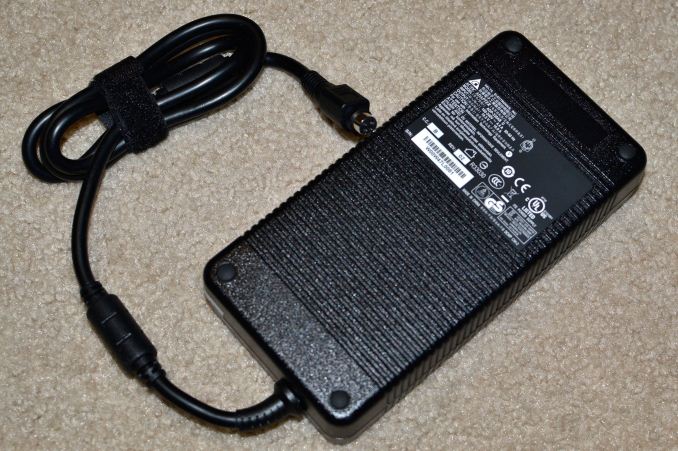Eurocom P5 Pro / Clevo P750ZM Review: True DTR
by Jarred Walton on March 10, 2015 10:00 AM EST
Eurocom P5 Pro / Clevo P750ZM Introduction
Some people look at notebooks as a way to cut the cord and go mobile for long periods of time, but others view the portability as a mere convenience while they move from one power socket to another (e.g. from home to the office). If you’re mostly running with your notebook connected to the power grid and you need the absolute fastest processor possible, there are some interesting options.
Clevo is pretty much the go-to option these days for desktop replacements (DTR), with the ability to support full performance desktop processors (including LGA2011 options) and up to two GTX 980M graphics cards in SLI on their top models. Today we’re looking at the next step down from that, the P750ZM that supports Haswell processors up to the i7-4790K and a single GTX 980M graphics chip.
We’ve already seen with the MSI GT72 that the GTX 980M is quite the potent mobile GPU, and in fact the GPU is so fast that there are times (especially at lower quality settings) where it becomes CPU limited. Moving up to an 88W i7-4790K should remove most of the CPU bottleneck, at least at settings anyone is likely to use, so let’s see exactly how fast the 980M can run with a desktop processor.
We’ve noted before that there are only a handful of true high-end notebook providers: Alienware, ASUS, Clevo, Gigabyte, and MSI are pretty much it, with a few companies like Razer and Gigabyte’s AORUS brand maxing out at the GTX 970M. We’re working on a review of Gigabyte’s rather slim P35W v3 as well, which is almost insanely thin for a full 980M laptop, but we’ll hold off on further comparisons until that review is ready.
As for the Clevo P750ZM, our sample laptop comes courtesy of Eurocom, where it’s sold as the Eurocom P5 Pro. While Eurocom may offer a few tweaks and options you might not find in stock configurations at other vendors, I have to be brutally honest here and say that there’s not much that separates the various branded Clevo notebooks from each other – Clevo, Eurocom, Sager, or whatever else you want to call it, “A rose by any other name would smell as sweet.” The main factors when buying any Clevo notebook are going to be price and component options.
Of course that doesn't mean there are no differences between the various vendors. Eurocom is one of the few (only?) vendors to offer a TPM 2.0 security chip on the P750ZM, and they also offer Radeon R9 M290X graphics (though at this stage in the life cycle I'm not sure why you'd want to go with AMD's Pitcairn-derived GPU). Finally, Eurocom uses IC Diamond 7 thermal paste on their notebooks, where many vendors charge extra for that feature.
Moving on to the component side of things, Eurocom doesn’t disappoint, with a pretty well fully loaded solution being available. You can choose between several 1080p display options, as well as two different 4K panels (including the 4K Sharp IGZO display in our test sample). Four SO-DIMM slots allow for up to 32GB RAM, there are two M.2 slots (SATA or PCIe supported, though RAID requires SATA), another two 2.5” drive bays, and five USB 3.0 ports (with one being an eSATA combo port). Here are the full specifications for our review unit:
| Eurocom P5 Pro / Clevo P750ZM Specifications | |
| CPU | Core i7-4790K (Quad-core, 4.0-4.4GHz, 8MB L3, 88W) |
| GPU | NVIDIA GeForce GTX 980M 8GB (1536 CUDA cores, 1038MHz + Boost, 256-bit 5010MHz GDDR5) |
| RAM | 16GB (2x8GB) Corsair Vengeance DDR3-1866 (Two additional SO-DIMM slots available) |
| SSD | 256GB M.2 SATA SSD Array (2x128GB Crucial M600 in RAID 0) |
| HDD | 1TB 7200RPM (HGST 7K1000-1000 |
| Optical | N/A |
| Display | 15.6" Glossy 4K (3840x2160) (Sharp IGZO LQ156D1JX01B) |
| Networking | Killer N1525 Combo (2x2 802.11ac + BT 4.0) Realtek RKL8111/8168/8411 Gigabit Ethernet |
| Audio | Realtek ALC892 2.1 speakers Four audio jacks |
| Front | N/A |
| Left | 1 x USB 2.0/eSATA Combo Flash Reader (SDXC/SDHC/MMC) 3 x USB 3.0 Ethernet |
| Right | 1 x USB 3.0 4 x Audio jacks Kensington Lock |
| Rear | Left/Right Exhaust Vents 2 x DisplayPort 1.2 1 x HDMI 1.4 AC Adapter |
| Input | 102-Key Keyboard Multi-touch Touchpad |
| Power | 8-cell ~82Wh battery 330W AC adapter |
| Extras | 2MP webcam Configurable Multi-colored Backlighting Fingerprint Scanner TPM 2.0 Security Chip 100% Cooling Switch (Fn+1) |
| OS | Windows 8.1 Professional 64-bit |
| Dimensions | 15.4" x 10.48"x 1.4" (386mm x 262mm x 35mm) |
| Weight | 7.48 lbs. (3.4kg) |
| Pricing | Starting at $1995 with GTX 980M $3192 as Configured |
Short of an SLI equipped notebook, this is pretty much the fastest system currently possible, and the only areas left to upgrade over the configuration we’re testing would be via increasing the amount of memory and/or solid state storage. Otherwise, Eurocom sent us the maximum performance/quality configuration in every respect. We’ve got a Core i7-4790K that’s overclockable (more on that later), the GTX 980M, a 4K IGZO display, 16GB of DDR3-1866 RAM, 256GB of SSD storage, and even the optional 330W power adapter (again, more on that later).
Interestingly, Clevo even dropped support for optical drives on this chassis, which seems a bit odd as Gigabyte manages to stuff a slim optical drive into a much thinner 15.6” chassis. Of course, I rarely use optical drives these days so it’s not a huge concern, but it’s something to be aware of. It’s also worth pointing out that battery life isn’t going to be a strong point on this system; even with a large 82Wh battery the high performance components will typically mean two hours of light use while unplugged, and if you want to try doing some gaming you can easily drain the battery in under an hour.
Considering the P750ZM is a full desktop replacement notebook, including an 88W desktop processor, it’s actually surprising that the system isn’t bulkier. Older Clevo models that supported desktop CPUs were often in the 10+ pound range, but the P750ZM is at least reasonably portable at 7.5 pounds. Of course, that’s not including the AC power brick, and with the 330W model we received it tips the scales at an impressive 2.6 pounds (1.2kg) all by itself. Yes, the 330W power brick actually weighs more than some 13” Ultrabooks.
The default 230W adapter should be lighter and less bulky, but there’s a reason for going the 330W route, specifically overclocking. I’m planning a separate article to do a deeper investigation of overclocking potential with the P750ZM, but under full load I’ve seen power draw at the outlet hit 260-270W. At 85% efficiency that would be a 100% load on a 230W adapter, so it’s still possible to use the default adapter and that will save you about $75-$100, but if you’re buying this sort of system it’s probably not a bad idea to opt for the 330W adapter.
Pricing as usual is going to be the biggest obstacle to overcome. There’s no getting around the fact that $2000 is a lot of money for a notebook, and as configured we’ve passed the $3000 mark. I checked around and Eurocom is generally slightly more expensive than some of the other Clevo resellers – and if you’re okay with a preconfigured unit, Amazon has some options as well – but there are differences in the specific RAM and SSD modules so I won’t belabor the point. Obviously this system is designed to set performance records for our notebook test suite, and it does.












74 Comments
View All Comments
rowny - Tuesday, March 10, 2015 - link
So you got a sample from Clevo resellers after all ? :)Now that's a laptop.
Are you considering to review Clevo P651SG ? Less bulky and scary :)
Flunk - Tuesday, March 10, 2015 - link
No, that's a desktop replacement. You don't want to put that thing on your lap. Still, it works for the segment it's in, top performance with near-desktop bulk.JarredWalton - Tuesday, March 10, 2015 - link
We can certainly try to get the P651SG for review to see how it compares with the others. I suspect it will be quite similar in performance to the Gigabyte P35W v3 review I'm working on, so it's more a question of whether you like the Clevo design more.rowny - Wednesday, March 11, 2015 - link
It would be nice to see whether the desktop CPU really gives an edge in games over the mobile 4720HQ in the P651SG. The latter has soldered GPU and CPU though.Stuka87 - Tuesday, March 10, 2015 - link
They crammed a 4790K into a laptop?! Thats gutsy. Although I suppose not technically a laptop, more like a portable workstation. I think if it was mine I would choose a 4690K over the 4790K, they run noticeable cooler, even when overclocked to the same speeds.Kjella - Tuesday, March 10, 2015 - link
I used to be a consultant visiting 2-3 clients a week working on their systems but my laptop was my testbed. The software was like a 747, doesn't matter if it's one or a hundred clients but it was a heavy beast to get off the ground. That's exactly the niche this machine is built for, high specs/performance running on-site, on power but portable between installations. I even used one with a defective battery for a year or so, didn't matter.will54 - Wednesday, March 11, 2015 - link
with the Clevo P577wm having had extreme desktop CPU and 2 GPU's so this has been done for years, though this might be the first 15" notebook to go with a desktop cpu.Notmyusualid - Sunday, March 15, 2015 - link
Not quite my friend. May I introduce you to my Eurocom, from 2000, 1st 1GHz Desktop CPU in a laptop, with 133MHz FSB.It was fully loaded, and around ~$5k at the time, coming with a MASSIVE 512MB of RAM.
The fact that it had built in Firewire, V.90 modem, dual PCMCIA, dedicated video card with a whole 16MB of vram, dual HDDs. What I really liked was the screen, resoultion of 1400x1050 at 15", which still betters some craptops sold today.
Link: http://www.eurocom.com/ec/configure%281,25,0%29
Also, a bit of a timeline on Eurocom (and thus Clevo, in effect):
http://www.eurocom.com/ec/innovations%28%29ec
The keyboard and build quality / aesthetics were pretty poor though. I gave it away to a buddy in 2008, and he seemed quite pleased with it. But man did it get hot, as did the 1.7GHz one I had about 5yrs later (also a desktop cpu). My M570RU (with mobile cpu) was much, much better though, in every way.
I'm pretty much an Alienware convert now though, but I could be tempted if price, spec, and screen were right...
flyingpants1 - Tuesday, March 10, 2015 - link
88W ? There's no way it's an 88W chip. Even the desktop version is 4790S which is 65 watts. And Haswell mobile is 47 Watts with most of the performance. The MSI has double the battery life.flyingpants1 - Tuesday, March 10, 2015 - link
Wow. Just.. wow. I understand desktop replacement, but 4790k overclocked is overkill.Is there a version with GTX 980m, but without a desktop CPU?